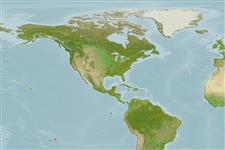Common names from other countries
>
Blenniiformes (Blennies) >
Blenniidae (Combtooth blennies) > Salariinae
Etymology: Praealticus: Latin, prae = in front of + Latin, altus, alticus = nutritious.
More on author: Seale.
Environment: milieu / climate zone / depth range / distribution range
Οικολογία
Θαλασσινό(ά). Tropical; 21°S - 24°S, 176°W - 128°W
Western Central Pacific. Eastern Central Pacific: Pitcairn (Ref. 41650) and French Polynesia (Ref. 46206).
Μέγεθος / Βάρος / Age
Maturity: Lm ? range ? - ? cm
Max length : 7.9 cm SL αρσενικό/απροσδιόριστο; (Ref. 54980)
Ραχιαίες άκανθες (συνολικά): 13; Μαλακές ραχιαίες ακτίνες (συνολικά): 17-20; Εδρικές άκανθες 2; Μαλακές εδρικές ακτίνες: 19 - 22. Lip margins smooth; females dorsally whitish to light gray and ventrally white with a series of 6 paired black spots (anterior 2 pairs irregular with a row of spots above) on upper side of body, and 1 spot on caudal peduncle, each connected by a gray bar to a lower series; a black line on back at spinous portion of dorsal fin, and 4 pairs of small black spots along base of soft portion; small bluish white spots on posterior half of body, mostly on upper half; narrow black bars ventrally on head angling on to throat; a white line at posterior edge of eye continuing below to upper lip; median fins with blackish margins; posterior part of crest with a narrow pink margin and a broad, submarginal black band; dorsal-fin base with alternating black and whitish blotches; a black spot at midbase of caudal fin; males similar except with darker body; bluish white spots on body generally elliptical; faint oblique black bands on throat; oblique white lines in soft portion of dorsal fin. Last spine of dorsal fin very small; dorsal soft rays usually 19; anal soft ray rarely 19 or 22; middle 6-9 of 14 segmented caudal rays branched; lateral-line pores 5-9 (Ref. 54980).
Facultative air-breathing (Ref. 126274); Adults are found in tidepools (Ref. 54980). Oviparous. Eggs are demersal and adhesive (Ref. 205), and are attached to the substrate via a filamentous, adhesive pad or pedestal (Ref. 94114). Larvae are planktonic, often found in shallow, coastal waters (Ref. 94114).
Life cycle and mating behavior
Γεννητική Ωρίμανση | Αναπαραγωγή | Γεννοβολία | Αβγά | Γονιμότητα | Προνύμφες
Oviparous, distinct pairing (Ref. 205).
Springer, V.G., 2001. Blennidae. Blennies (combtooth and sabertooth blennies). p. 3538-3546. In K.E. Carpenter and V. Niem (eds.) FAO species identification guide for fishery purposes. The living marine resources of the Western Central Pacific. Vol. 6. Bony fishes part 4 (Labridae to Latimeriidae), estuarine crocodiles. FAO, Rome. (Ref. 12848)
IUCN Red List Status (Ref. 130435)
CITES (Ref. 128078)
Not Evaluated
Threat to humans
Harmless
Human uses
Περισσότερες πληροφορίες
ΑναφορέςΥδατοκαλλιέργειεςΠροφίλ υδατοκαλλιέργειαςΣτελέχοιΓενετικήElectrophoresesΚληρονομικότηταΑσθένειεςΜεταποίησηMass conversion
ΣυνεργάτεςΦωτογραφίεςStamps, Coins Misc.ΉχοιΣιγκουατέραΤαχύτηταΚολυμβητικός ΤύποςΕπιφάνεια βραγχίωνOtolithsΕγκέφαλοιΌραση
Εργαλεία
Special reports
Download XML
Διαδικτυακές πηγές
Estimates based on models
Preferred temperature (Ref.
115969): 24.7 - 25.9, mean 25.6 (based on 21 cells).
Phylogenetic diversity index (Ref.
82804): PD
50 = 0.5001 [Uniqueness, from 0.5 = low to 2.0 = high].
Bayesian length-weight: a=0.00741 (0.00335 - 0.01640), b=3.02 (2.83 - 3.21), in cm Total Length, based on LWR estimates for this (Sub)family-body shape (Ref.
93245).
Τροφικό Επίπεδο (Ref.
69278): 2.0 ±0.00 se; based on food items.
Ελαστικότητα (Ref.
120179): Υψηλό, ελάχιστος χρόνος για διπλασιασμό πληθυσμού < 15 μήνες (Preliminary K or Fecundity.).
Fishing Vulnerability (Ref.
59153): Low vulnerability (10 of 100).
